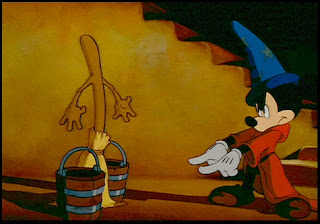 The other day I was waiting in line at the post office and was scanning the walls, bored enough to read the various posters. One of them promoted a new line of stamps that is available. As I looked at the familiar images I was reminded that for some time aspects of the entertainment industry have been using fantasy and film to promote magic to our children.
The other day I was waiting in line at the post office and was scanning the walls, bored enough to read the various posters. One of them promoted a new line of stamps that is available. As I looked at the familiar images I was reminded that for some time aspects of the entertainment industry have been using fantasy and film to promote magic to our children.
One of the more prevalent sources is reflected in this new series of stamps. I noted how the image looked innocent enough. Nevertheless, the image was that of a young sorcerer, or would-be sorcerer, who was using magic even while improperly schooled in it. In case the reader is wondering I’m not talking about Harry Potter, I’m talking about the various ways in which Disney Studios has presented magic in their cartoons over the years. And for those of you who might be worried, no, I write above with tongue in cheek.
The series of stamps I referenced featured Mickey Mouse as the Sorcerer’s Apprentice. I still remember that cartoon with its wonderful music, and the story of the sorcerer who steps out and leaves Mickey to mop up. He decides to use his sorcerer’s wand to animate mops and buckets, only to see it get out of control and needing to be rescued by the end of the cartoon by the returning sorcerer. Another stamp picking up on Disney’s magical theme was from Aladin, and yet another shows Tinker Bell with her magical dust.
I find it interesting that while Disney and other sources of popular entertainment have drawn upon fantasy magic for quite some time, in the past we did not see the outcry that we do in some segments of Protestant evangelicalism and fundamentalism today. Apparently a previous generation was able to recognize fairytale magic, even when it included sorcerers and magic wands.
This is not a major observation, but it presents a few items for our consideration, particularly since the most recent Harry Potter film is about to be released in theaters, and the last of the books will hit bookstores in the U.S. by month’s end. While it has been difficult to sustain anti-Potter rhetoric for an extended period of time, no doubt those Christians concerned with Potter’s alleged Witchcraft, occultism, and magic will sound their warnings soon.
I’d like to suggest that the Christian community needs to consider a few things in light of all of this. First, we need to reassess our understanding of fairytales and magic, and how this does nor does not connect to the real practices of Western esotericism. I commented on what has been called “occult-tinged fiction” a while back, and some interactions with colleagues provokes my continued reflection on this. Second, we need to reconsider the appropriate interpretation of literature and film. Even if we were to grant that an author or screenplay writer were drawing upon “occultic” or Pagan sources, the meaning of such elements are defined by the author within the story’s narrative, not from their supposed origin outside of the story. This is a basic hermeneutical principle, but one which is frequently neglected. Third, we need a good understanding of Western esotericism and Neo-Paganism. I’m afraid that Harry Potter and Hogwarts are closer to the Witches of The Wizard of Oz than they are Fiona Horn. The conflation of all such things including fairytales and real spiritualities like esotericism and covering them with the label “occult” is inaccurate, sensationalistic, and it makes Christian “experts” on such topics look just plain silly.
Perhaps the upcoming release of the Potter film and book will provide Christians with an opportunity for critical self-reflection, and will result in the ability to distinguish between a magical mouse and a Western form of spirituality.





There are no responses yet